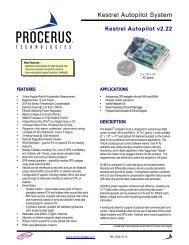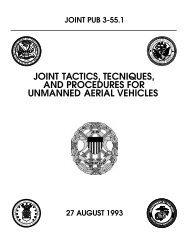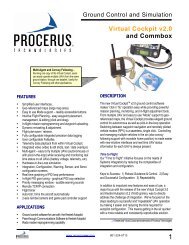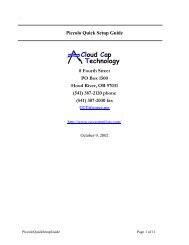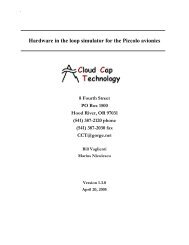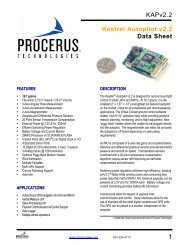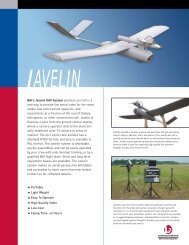Piccolo system user guide - Unmanned Aircraft & Drones
Piccolo system user guide - Unmanned Aircraft & Drones
Piccolo system user guide - Unmanned Aircraft & Drones
Create successful ePaper yourself
Turn your PDF publications into a flip-book with our unique Google optimized e-Paper software.
Clo ud Cap<br />
Technology<br />
PO Box 1500, No. 8 Fourth St, Hood River, OR 97031, ph 541 387 2120, fax 541 387 2030<br />
• Complete hardware integration including sensors, datalink, and servo drivers.<br />
• Wide range of software support, including complete end-<strong>user</strong> programmability.<br />
• Reference software design for ground station and simulation tools.<br />
• Fully autonomous or pilot in the loop operation.<br />
• Attitude independent installation.<br />
1.2 CPU<br />
The heart of <strong>Piccolo</strong> is the MPC555 microcontroller. This is a new breed of automotive<br />
controller based on the PowerPC architecture. The MPC555 marries an enormous array of<br />
interfaces to a powerful RISC engine that delivers 40Mhz PowerPC operation, including<br />
hardware floating point.<br />
1.3 Sensors<br />
<strong>Piccolo</strong> features three Tokin CG-16D rate gyros and two two-axis ADXL202 accelerometers,<br />
which combined with its CPU horsepower gives <strong>Piccolo</strong> the ability to run sophisticated filters;<br />
and allows installation in any attitude. The <strong>Piccolo</strong>Plus uses three ADXRS300 gyros and two<br />
two-axis ADXL210e accelerometers.<br />
<strong>Piccolo</strong> includes a dual ported mpxv50045 4kPa dynamic pressure sensor, an absolute ported<br />
mpx4115a barometric pressure sensor, and a board temperature sensor. Together these sensors<br />
provide the ability to measure true air speed and altitude.<br />
The Motorola M12 GPS provides <strong>Piccolo</strong> with its basic groundspeed and position. The M12 is<br />
differential capable, and <strong>Piccolo</strong> will supply it with any DGPS corrections received over the<br />
datalink. The <strong>Piccolo</strong> ground station is capable of generating these corrections using its own<br />
M12.<br />
<strong>Piccolo</strong> can generate an estimate of winds aloft each time the aircraft turns by fitting true<br />
airspeed against GPS groundspeed. The wind estimate is useful since it enables an intelligent<br />
selection of heading when the wind speed exceeds the flight speed of the aircraft.<br />
1.4 Servos<br />
<strong>Piccolo</strong> includes 10 servo outputs. These outputs are geared for model aircraft servos, which<br />
require pulse-width modulated signals, and 4-6 volt power. Alternatively some servo <strong>system</strong>s<br />
use a CAN (Controller Area Network) bus to provide the servo signals. <strong>Piccolo</strong> includes two<br />
independent CAN buses. In either case the servo power supply is isolated from the main logic<br />
power supplies so that transient servo loading doesn’t disable core <strong>system</strong> functions.<br />
1.5 Datalink<br />
<strong>Piccolo</strong> includes a sophisticated datalink that is built on the MHX 910/2400 radio modem from<br />
Microhard Systems Inc. The datalink has up to 40Kbaud of throughput and is used for command<br />
and control, autopilot telemetry, payload data transfer functions, differential GPS corrections<br />
uplink, and pilot in the loop modes. The datalink architecture allows multiple aircraft to be<br />
controlled by a single operator from a single ground station.<br />
<strong>Piccolo</strong> User’s Guide Page 5



